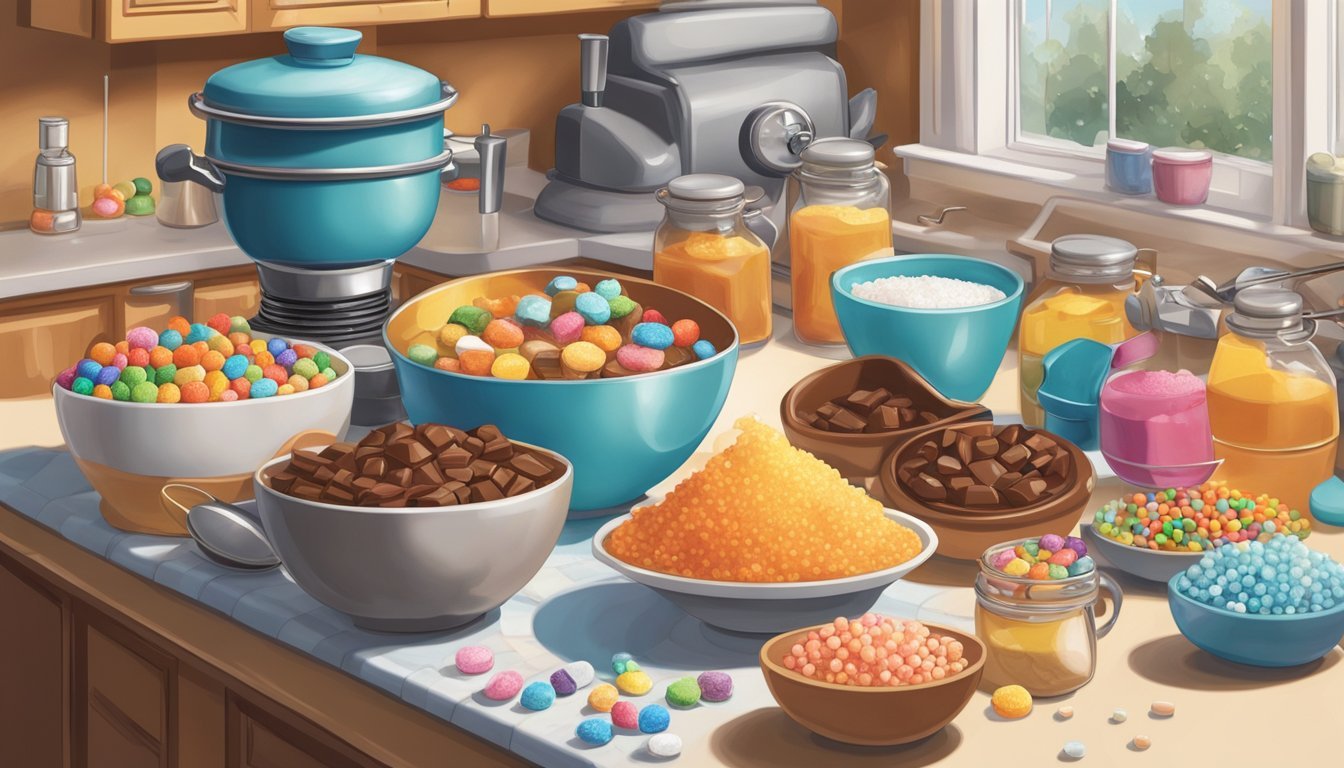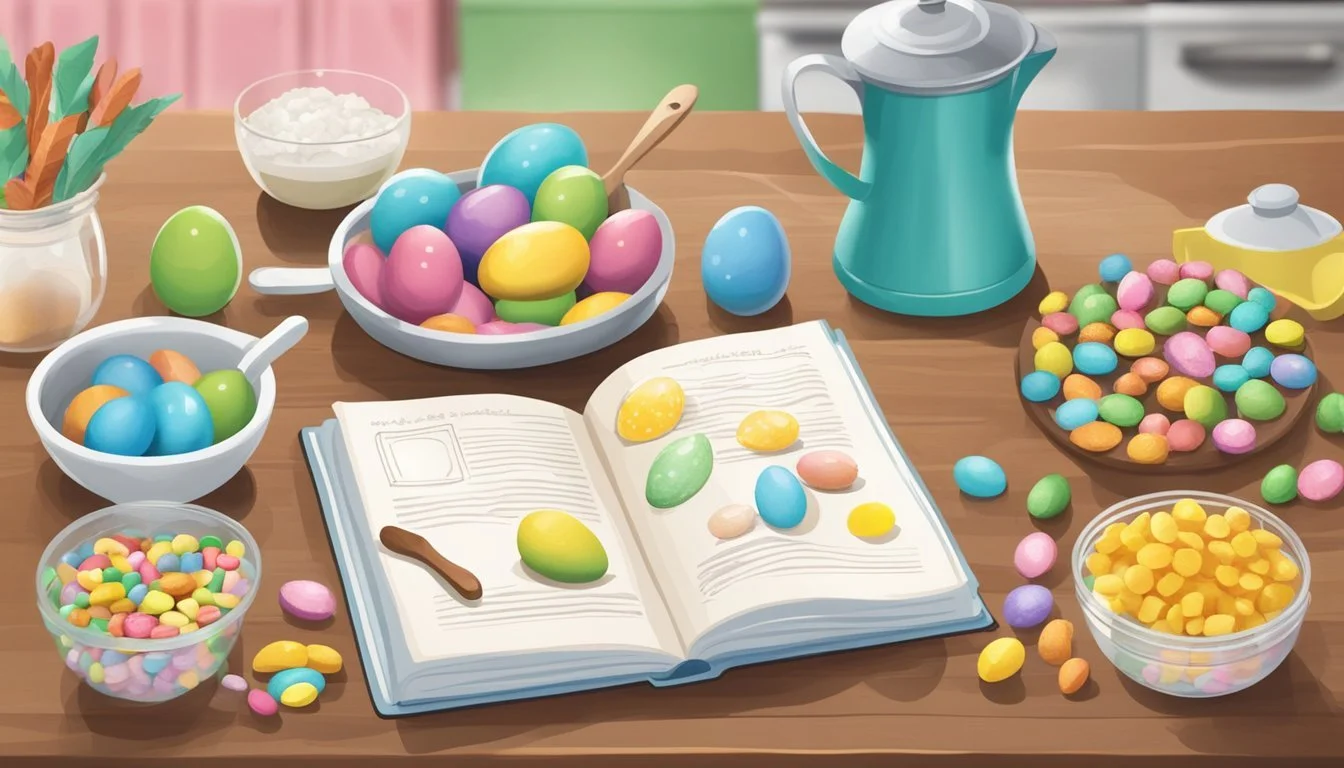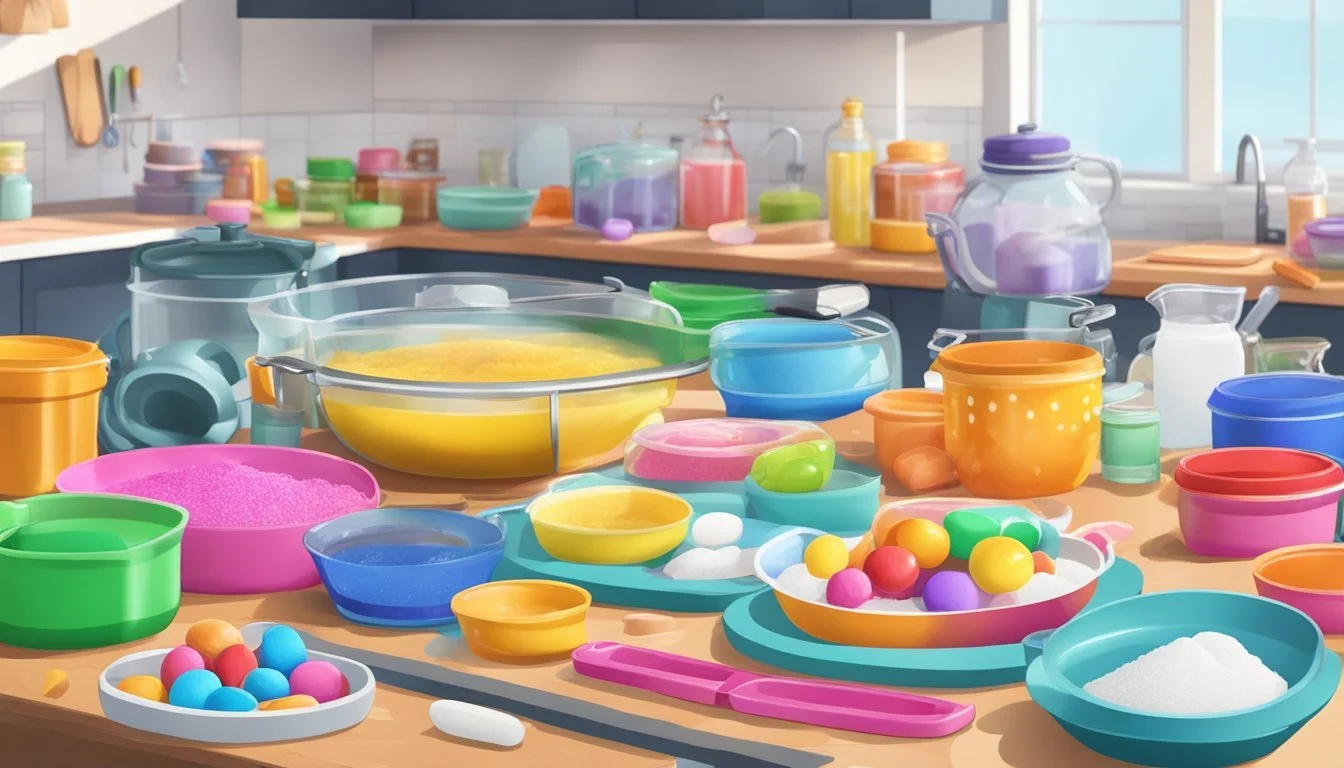The Country Kitchen's Easter
Guide to Homemade Candy Traditions
Easter in the country kitchen embraces the joy of making homemade candy, turning it into a festive and interactive occasion. The preparation of such confections is not only a delightfully engaging activity but it also adds a personal touch to festive celebrations. Simple recipes empower anyone to craft delicious treats without the need for extensive culinary skills or equipment. From rich chocolate (What wine goes well with chocolate?) eggs to colorful jelly bean bark, the options are limitless, allowing for creativity and customization that store-bought candy simply cannot match.
The allure of homemade Easter candy lies in its ability to bring families and friends together in the kitchen, creating both sweet treats and cherished memories. No-bake options bring further ease to the process, offering fun and approachable methods for all, regardless of baking expertise. Utilizing ingredients like marshmallows, coconut flakes, and candy melts, even children can participate in the creation of Easter goodies.
The culmination of these homemade candy-making ventures is not just the delicious end product but also the satisfaction associated with the craft. Knowing that the array of candies on the Easter table is the fruit of one's own labor adds a sense of pride to the holiday festivities. Whether used as an element of decor or as a centerpiece for the Easter basket, these treats encapsulate the spirit of a traditional and heartwarming country Easter.
Essential Ingredients for Candy Making
High-quality ingredients are crucial for crafting delectable homemade Easter candy. This selection not only ensures a flavorful outcome but also enriches the presentation of the candy.
Chocolate Varieties
When selecting chocolate for candy making, one should consider different types such as white chocolate, milk chocolate, and dark chocolate. Brands like Ghirardelli and Bakers offer a variety of options, categorized mainly by cocoa content, which directly affects the taste and texture of the candy.
White Chocolate: Contains cocoa butter (how long does butter last?), sugar, and milk solids and lends a creamy texture.
Milk Chocolate: Known for its smooth and sweet flavor, it is versatile for many candy types.
Dark Chocolate: Valued for its rich, intense flavor, it pairs well with various fillings and is available in different levels of cacao content.
Fillers and Add-ins
Fillers like nuts, pretzels, and caramel are popular for adding a delightful crunch or chew to homemade candies. Add-ins contribute both to taste and aesthetics, especially when using sprinkles in pastel colors, aligning with the Easter theme.
Nuts: Choose from almonds, pecans, or cashews for a satisfying crunch.
Pretzels: Their salty flavor complements the sweet chocolate, creating a balanced taste profile.
Caramel: Homemade or store-bought, it adds a gooey, rich element to candy bars and chocolates.
Sugars and Sweeteners
Sugar is the fundamental sweetener in candy making. It's crucial to choose the right type for the texture desired.
Granulated Sugar: The most common sweetener, perfect for achieving a brittle candy texture.
Sweetened Condensed Milk: Often used in fudge and truffles (What wine goes well with truffles?) for its creamy sweetness and thick consistency.
Peanut Butter: It acts as a flavorful sweetener with a uniquely rich taste that pairs excellently with chocolate.
By focusing on quality and variety, these essential ingredients lay the groundwork for an array of homemade Easter candies that are sure to impress.
Candy Making Equipment and Materials
When embarking on the venture of homemade candy making for Easter at Country Kitchen, one should pay close attention to acquiring appropriate equipment and materials. Quality molds, precise dipping tools, and reliable appliances are essential for creating delectable confections that delight the senses.
Molds and Dipping Tools
Molds: For candy making, especially hard candies and chocolates, molds are indispensable. They come in various shapes, including Easter-themed designs, perfect for the holiday. Country Kitchen offers a range of molds that cater to individual preferences and candy types.
Hard Candy Molds: These are typically made of plastic or silicone and are used for shaping sugar-based candies.
Chocolate Molds: Often constructed from polycarbonate, these molds give chocolates a professional finish and can withstand the high temperatures of melted chocolate.
Dipping Tools: Proper dipping tools are designed to make the coating process cleaner and more efficient. For chocolate-dipping, essential tools include:
Forks: Allow excess chocolate to drip away and help in positioning the candy on the parchment paper.
Toothpicks: Useful for intricate detail work or for dipping smaller items.
The use of vegetable oil or coconut oil is often recommended to thin chocolate, ensuring a smooth dipping consistency. When finished, candies are usually set on parchment paper to harden without sticking.
Appliances and Accessories
Appliances: Certain appliances greatly enhance the candy-making process by offering control and consistency.
Double Boiler: Essential for gently melting chocolate chips and melting wafers without burning them. A slow cooker can also serve a similar function, allowing for a uniform heat distribution when melting large quantities.
Food Processor: Useful for fine chopping nuts or pureeing fruits for inclusion in candy recipes.
Accessories: A few additional accessories that should be included in the candy maker's toolkit are:
Melting Wafers: They come in a variety of flavors and are specifically formulated for melting and candy-making.
Parchment Paper: Lining trays with parchment paper prevents candies from sticking and allows for easy cleanup.
With the right equipment and a selection of quality materials, anyone can master the art of making homemade candy, and The Country Kitchen's extensive assortment provides everything needed for Easter confections.
The Process of Making Homemade Candy
The creation of homemade candy for Easter involves a blend of precision in preparing mixtures and bases, creative shaping and setting, and a final flourish of dipping and decoration. Each step is pivotal for crafting delicious and visually appealing confections.
Preparing Bases and Mixtures
Homemade candy begins with the careful preparation of bases and mixtures. For chocolate candies, melting is the fundamental step. It is crucial to gently melt the semi-sweet chocolate or bittersweet chocolate to avoid burning. Tempering is often used for high-quality chocolates, ensuring a smooth and shiny finish upon setting. To temper chocolate, one method involves heating the chocolate until it's fully melted, then cooling it slightly before reheating it to a lower temperature. For recipes utilizing a non-chocolate base, one may start with combining ingredients like sugar and butter, then blending it with other flavors or textures.
Chocolate Melting Guidelines:
Semi-Sweet Chocolate: Melt at 115°F, then cool to 80-82°F, and finally reheat to 88-90°F.
Bittersweet Chocolate: Melt at 120°F, cool to 80-82°F, and reheat to 88-90°F.
Shaping and Setting Candy
Once the bases are mixed, the shaping stage gives candies their Easter charm. This could be casting chocolate into molds resembling festive shapes or forming balls of sweet mixtures by hand. After shaping, chilling is often required to set the candy. A refrigerator can set chocolate at a moderate pace, preserving its texture, while freezing may be necessary for quicker setting or for more intricate designs that need to hold their shape firmly.
Chilling Times:
Refrigerate: Place candies in the refrigerator for 1-2 hours.
Freezing: Freeze candies for 30 minutes or until firm.
Dipping and Decoration Techniques
The final artistic touch involves dipping and decorating. Using melted chocolate, artisans can dip shaped candies to create a thin, even coating. Tempering comes into play again here for that desired gloss and snap. While the chocolate is still wet, one can embellish the candy with festive sprinkles, adding colors and textures. Pastel sprinkles are particularly popular during Easter, lending a seasonal and adorable appeal to the finished treats.
Decoration Tips:
Apply festive sprinkles immediately after dipping to ensure they adhere.
Work in batches to keep decorations neat and the process manageable.
Popular Easter Candy Recipes
Preparing homemade Easter candy is a delightful way to celebrate the holiday season. From silky chocolate coverings to rich buttery fudges, the following recipes offer a range of treats that promise to impress any Easter gathering.
Chocolate-Covered Delights
Chocolate lovers often gravitate towards treats like Chocolate-Covered Eggs and Chocolate-Covered Pretzels. A classic is the chocolate peanut butter egg, which combines smooth Peanut Butter Filling with a chocolate shell. Recipes may advise the use of Candy Melts for a glossy, professional-looking finish.
Chocolate Peanut Butter Balls right balance of creamy peanut butter core and a thin chocolate shell.
Chocolate-Covered Pretzels offer a perfect sweet and salty crunch.
Butter and Fudge Treats
The rich, creamy textures of butter and fudge treats like Peanut Butter Fudge Cups and Chocolate Fudge are especially popular. Many families have their secret recipes that have been passed down through generations.
Salted Caramels combine the buttery sweetness of caramel with a light sprinkle of sea salt.
Jelly Bean Fudge infuses the classic fudge recipe with the colorful and fruity punch of jelly beans.
Truffles and Filled Candies
For those who enjoy the mouthfeel of a soft center, Easter Egg Oreo Truffles and White Chocolate Blueberry Truffles offer a surprise in every bite. These treats can be crafted to hide a variety of fillings, like the ever-popular Easter Egg Peanut Butter Candies.
Easter Egg Oreo Truffles, which incorporate crushed Oreos and cream cheese, are often a hit.
White Chocolate Blueberry Truffles – a concoction of white chocolate ganache with a burst of blueberry.
Easter-Themed Creations
In the bustling Country Kitchen, the Easter season unfolds with a symphony of pastel candies and confections shaped like iconic holiday figures. From peanut butter-packed delicacies to whimsical shapes captivating the essence of Spring, the kitchen staff prepares an array of homemade candies that offer a personal touch to the holiday festivities.
Festive Candy Variations
The Country Kitchen prides itself on its vast selection of Peanut Butter Eggs and Pastel Candies. Each peanut butter egg is meticulously crafted, balancing the rich, creamy filling with a smooth chocolate exterior. The pastel candies, tinted in the soft hues of spring, are favorites for their ability to double as both treats and decorative accents.
Peanut Butter Eggs: Wrapped in festive foil, these eggs feature a velvety filling.
Pastel Candies: Offered in a spectrum of spring colors, adding to the holiday's vibrancy.
Barks and Brittles
Easter Bark emerges as a standout with its layers of chocolate interlaced with a variety of textures and flavors. Easter Oreo Bark, for instance, combines the crunch of cookie pieces with the snap of hardened chocolate. Bunny Tails and Peanut Butter Bunny Butt Pretzels add a playful twist to the bark family, infusing classic tastes with a dash of Easter joy.
Easter Oreo Bark: A blend of white chocolate and crushed Oreos.
Peanut Butter Bunny Butt Pretzels: A fun and salty-sweet snack mirroring the Easter Bunny.
Novelty and Fun Shapes
Efforts in the kitchen culminate with a delightful selection of candies like the Easter Bunny itself, accompanied by smaller but equally cherished Coconut Nests and Confetti Squares. These creations are not only delicious but serve as enchanting centerpieces for the Easter spread. Easter Egg Candies, hand-decorated with care, hide a surprise within, as various fillings burst with flavor upon tasting.
Easter Bunny: Chocolate bunnies that stand as a centerpiece for Easter celebrations.
Coconut Nests: These nests cradle festive eggs and are crafted using shredded coconut.
Advanced Candy Making Techniques
When making homemade candy for Easter, advanced techniques can address common issues and enhance the sensory appeal of sweets. Mastering these methods can elevate a confectioner's creations from simple treats to gourmet delicacies.
Troubleshooting Common Problems
Melting Chocolate: Chocolate is a key ingredient in many Easter candies, and its proper handling is crucial. When melting chocolate, use a double boiler and heat it slowly to prevent seizing. If the chocolate does become grainy, adding a teaspoon of coconut oil can sometimes restore its smoothness.
Vanilla Extract: This flavoring agent can enhance the taste of many candies, but it should be added after heating to preserve its flavor. Heat can cause evaporation, and with it, the subtle bouquet of vanilla can be lost.
Enhancing Flavors and Textures
Flavors and Salt: A pinch of salt can greatly enhance the nuanced flavors in candy, including chocolate. Sea salt, with its mineral complexity, is particularly adept at enriching flavors while adding a subtle crunch. A small amount of orange extract can also infuse a refreshing zing to chocolate-based candies, complementing the inherent richness of cocoa.
Chocolate Enhancement: To accentuate the flavor of chocolate, consider the type of salt used:
Sea Salt: Brings out chocolate's complex notes.
Table Salt: Can sharpen sweetness, but lacks texture.
Flavor Layers: Incorporate different extracts, like vanilla or orange, to create a more sophisticated taste profile.
Extract Effect on Flavor Vanilla Extract Adds warmth and depth Orange Extract Provides a citrusy freshness
By focusing on these advanced candy making techniques, one can troubleshoot common confectionary challenges and enhance the sensory zest of Easter treats.
Holiday Candy as Part of Wider Celebrations
Easter celebration often extends beyond the Sunday service to include a variety of home-based festivities. Easter Inspiration often comes from both religious and cultural traditions. In many households, the making of holiday candies is not just a fun activity but an integral part of the festivities, providing a sweet parallel to the savory delights of Easter Brunch Recipes.
An array of Easter Dessert Ideas typically follows the main meal, where homemade candies take center stage. They are not only treats but also double as decorative elements. Many families take pride in crafting their own Holiday Candies, merging creativity with traditional recipes to create memorable Easter experiences.
The Country Kitchen encourages families to explore homemade candy making with these key ideas:
Chocolate-Covered Eggs: A classic that draws inspiration from the German tradition of the "Osterhase", symbolizing rebirth.
Coconut Nests: These can hold small candies and are visually appealing as part of the Easter table spread.
Marshmallow Treats: Soft, fluffy, and versatile for shaping into Easter-themed figures.
The excitement for homemade candies grows each year, reflecting a trend where individuals look to personalize their celebration while embracing the communal aspect of sharing these sweet delights.
Easter Activity Description Candy Crafting Involves making homemade sweets, a fun activity for families and friends. Brunch Preparations Dishes are prepared that might include pastries, quiches, (What wine goes well with quiche?) and other savory items. Dessert Arrangement A variety of Easter-themed confections are served, with homemade candy as the focal point.
Homemade candy is more than just a treat; it embodies the spirit of Easter, bringing together culinary skill and festive joy.
Complementary Easter Treats and Ideas
When preparing Easter treats, it's essential to offer a variety of sweets and snacks. The Country Kitchen ensures your Easter is filled with not only delicious homemade candy but also with a selection of treats that complement the festive occasion.
Cookie-Based Confections
She uses Jelly Bean Sugar Cookies to add a splash of color and fun to the dessert table. These cookies incorporate vibrant jelly beans into the dough, creating a whimsical and tasty treat that's a hit with children and adults alike.
For an indulgent option, Nut Butter Cups are a classic choice. They consist of rich nut butter, such as peanut or almond, encased in silky chocolate. This confection is simple to make and offers a beloved combination of flavors.
Savory Snacks and Popcorn
In addition to sweets, The Country Kitchen recommends savory options for those who prefer less sugar. Popcorn serves as a light and versatile snack, which can be enjoyed plain or with a mix of Easter-themed spices and colors.
For a sumptuous twist, Caramel Corn includes a generous coating of golden caramel, transforming the humble popcorn into a gourmet treat. It balances the sweetness with a hint of salt, perfect for Easter grazing.
Assorted Chocolate Treats
They highlight various forms of chocolate indulgence, focusing on homemade goodness. Chocolate Truffles are a rich, bite-sized dessert that comes in an array of flavors from classic dark chocolate to fruit-infused varieties.
The kitchen also creates delightful Crockpot Candy, combining nuts and chocolate for an effortless yet decadent candy. This slow-cooked treat requires minimal hands-on time, allowing more moments to enjoy with family and friends.









